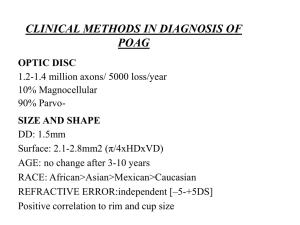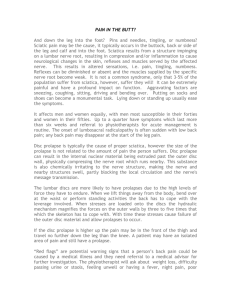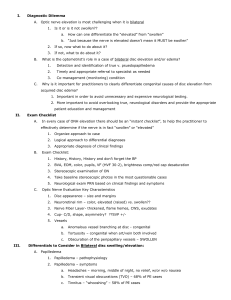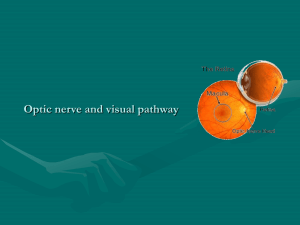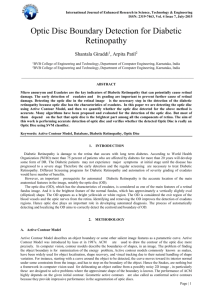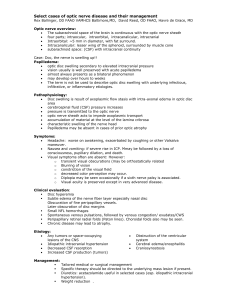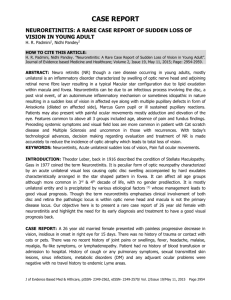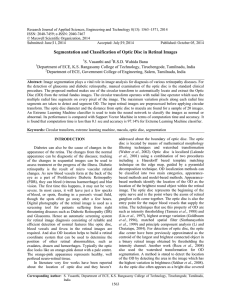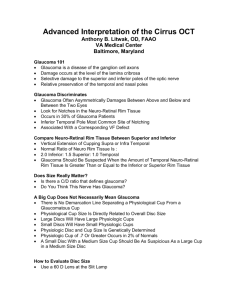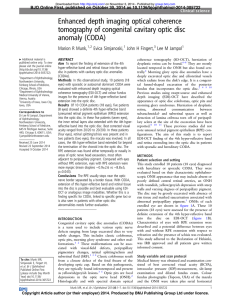Congenitally Full Disc
advertisement
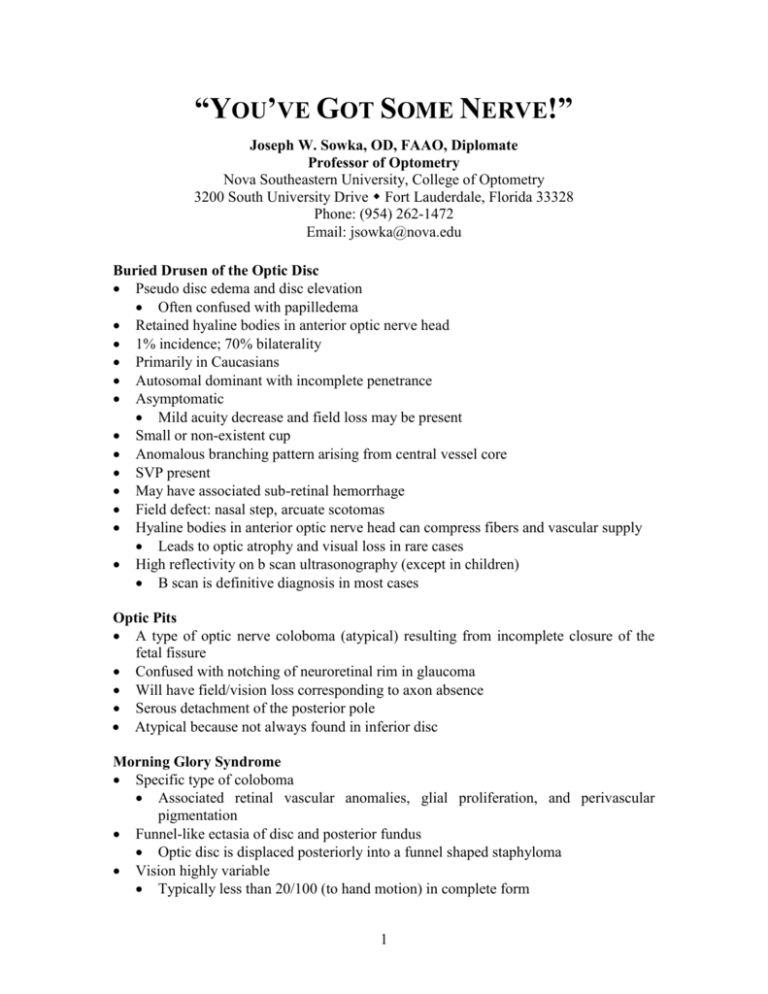
“YOU’VE GOT SOME NERVE!” Joseph W. Sowka, OD, FAAO, Diplomate Professor of Optometry Nova Southeastern University, College of Optometry 3200 South University Drive Fort Lauderdale, Florida 33328 Phone: (954) 262-1472 Email: jsowka@nova.edu Buried Drusen of the Optic Disc Pseudo disc edema and disc elevation Often confused with papilledema Retained hyaline bodies in anterior optic nerve head 1% incidence; 70% bilaterality Primarily in Caucasians Autosomal dominant with incomplete penetrance Asymptomatic Mild acuity decrease and field loss may be present Small or non-existent cup Anomalous branching pattern arising from central vessel core SVP present May have associated sub-retinal hemorrhage Field defect: nasal step, arcuate scotomas Hyaline bodies in anterior optic nerve head can compress fibers and vascular supply Leads to optic atrophy and visual loss in rare cases High reflectivity on b scan ultrasonography (except in children) B scan is definitive diagnosis in most cases Optic Pits A type of optic nerve coloboma (atypical) resulting from incomplete closure of the fetal fissure Confused with notching of neuroretinal rim in glaucoma Will have field/vision loss corresponding to axon absence Serous detachment of the posterior pole Atypical because not always found in inferior disc Morning Glory Syndrome Specific type of coloboma Associated retinal vascular anomalies, glial proliferation, and perivascular pigmentation Funnel-like ectasia of disc and posterior fundus Optic disc is displaced posteriorly into a funnel shaped staphyloma Vision highly variable Typically less than 20/100 (to hand motion) in complete form 1 Vision may be good in forme fruste Complete form is typically unilateral (though with other fellow eye colobomas) and forme fruste is typically bilateral Typically unilateral, but fellow eye often has other congenital defects Associated with non-rhegmatogenous retinal detachment of the posterior pole Oblique Insertion Hyperopia is typically present Typically bilateral Unchanging with no field defect Nasal aspect heaped up while temporal aspect depressed or buried Frequently misdiagnosed as glaucoma and disc edema Especially prominent in Asian patients Tilted Disc Syndrome Appears rotated about axis- long axis may be horizontal rather than vertical No actual rotation occurs. Inferior tissue is missing while superior tissue is crowded together. Overall appearance is of rotation. Abnormal morphology of chorioscleral canal gives this appearance Optic nerve and fundus typical coloboma due to incomplete closure of fetal fissure at 6 weeks gestation. Findings include: Inferior conus –inferior and inferior nasal Can extend to involve the optic nerve as well and mimic glaucomatous notching Corresponding field defect Ectasia Staphyloma Hypopigmentation of inferior fundus (retina, choroid, and RPE) Colobomatous disruption of RPE can lead to choroidal neovascularization Situs inversus Myopic astigmatism of oblique axis Due to inferior staphyloma Unchanging with possible stationary field defect- temporal defect Field defect is superior temporal corresponding to inferior nasal conus Optic Nerve Head Hypoplasia Congenitally small nerves with pronounced scleral crescent (double ring sign) Dysplasia of retinal ganglion cells with loss of NFL ONH underdevelopment and sclera “fills in” Associated brain disorders and gestational diseases Maldeveloped growth Associated disorders include: Gestational diabetes 2 Maternal infection (CMV, syphilis, rubella) Fetal alcohol syndrome Maternal drug abuse Septo-optic dysplasia Short stature Congenital nystagmus Hypoplastic disc Unchanging, but may have drastically reduced acuity and field Normal acuity to NLP Strabismus, typically esotropia, frequently present (50%) Must distinguish from amblyopia Amblyopia, refractive error, binocular anomalies are secondary to hypoplasia Upon discovery, patient (if child) should be referred for full neurologic and endocrinologic evaluation, esp. if associated neurological signs are present or child is abnormally small for age Physiologically Large Nerves and Cups: Megalopapillae Occur more commonly in patients with normally large chorioscleral canals and large discs Patients of color Common misdiagnosis of NTG and POAG Congenitally Full Disc Crowded and elevated discs Disc at risk in NAAION Small to normal size nerve head Vessels appear abnormally tortuous with anomalous branching patterns SVP typically present Mistaken for disc edema Neuroretinal rim is intact and hyperemic and there is no cup Acquired Myopic Crescent White flange of scleral tissue temporally in highly (6D-8D) eyes May be circumpapillary Does not affect vision Occurs as eye grows and elongates Posterior Staphyloma Degenerative change associated with progressive globe elongation Pathological myopia Extreme posterior ectasia Easily identified with ultrasonography Extreme retinal thinning with increased visibility of underlying choroid Nerve may be vertically oval 3 Extreme axial elongation and secondary retinal degeneration with severe vision loss May result from a collagen bundle defect and thinning Thinning and atrophy of the RPE, choroid, and sclera Lacquer cracks Breaks in Bruch’s membrane Predispose to choroidal neovascularization Poorly amenable to laser therapy as scar increases in size as eye elongates Fuch’s spots RPE hyperplasia overlying membrane Prepapillary Vascular Loops Congenitally misdirected retinal vessels Protrude into vitreous cavity 95% are arterial Come forth from cup into vitreous Spiral back on itself in corkscrew fashion Unilateral typically Actually a branch of central retinal artery (or vein) Exposure makes these vessels more prone to compromise Transient monocular blindness Vitreous hemorrhage Artery occlusion Usually occur in cases of altered perfusion such as glaucoma and carotid stenosis Must differentiate from collateral vessels Myelinated Nerve Fibers 1% incidence Unilateral Typically contiguous with optic disc White superficial opacification Obscures underlying vessels and disc margins Terminal edges display feathery/wispy/ frayed appearance following NFL Erroneous myelination Oligodendricytes proliferate into the eye and sheath axons while still in the NFL Stable and asymptomatic (though a relative field defect can be produced in rare cases), though changes have been noted in patients with demyelinating disease (multiple sclerosis Clinical Pearl: While cup to disc ratio has always been important in the diagnosis of glaucoma, this observation is not helpful when the patient has a congenitally anomalous disc. In these cases, the rules of C/D ratios do not apply. Clinical Pearl: Even congenitally anomalous discs can develop acquired pathologies. 4



